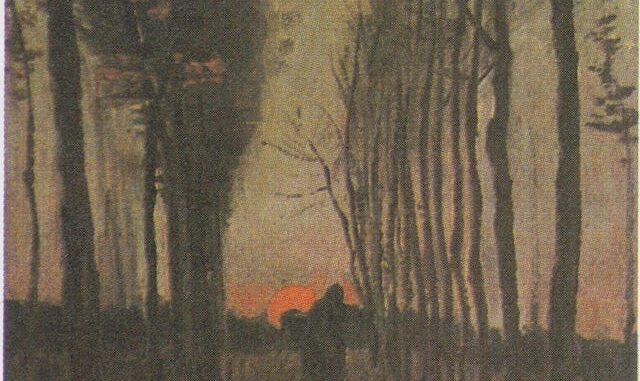
- A team of scientists recently used astronomy to date Vincent van Gogh’s painting Lane of Poplars at Sunset.
- The painting depicts a street named Weverstraat, which ran through the center of the town of Nuenen in the Netherlands, on either November 13 or November 14, 1884.
- Donald Olson, the astronomer who led the team that made this discovery, has previously employed this method to date three of van Gogh’s other works: Moonrise (Wheat Stacks), Road with Cypress and Star, and White House at Night.
Art can be wondrous in more ways than one. Take Vincent van Gogh’s Starry Night, for instance. It’s one of the most famous paintings in the world for its use of color and texture and its beautiful, swirling, flowing lines. But upon closer analysis, it also displays a fascinating understanding of complex atmospheric physics that the famed artists would have had no way of studying.
As compelling as the piece is, Starry Night isn’t the only one of van Gogh’s master works to have the eyes of the scientific world trained on it in the hopes of gathering more information about both painting and painter through in-depth analysis. In a research project published as a story in Sky & Telescope Magazine, a team lead by Donald Olson—astronomer and physics professor emeritus at Texas State University—figured out how to use astronomy to discover exactly what location is depicted in van Gogh’s Lane of Poplars at Sunset.
This is a method that Olson has actually employed before, according to a press release from Texas State University. He had previously dated the paintings Moonrise (Wheat Stacks), Road with Cypress and Star, and White House at Night via this astronomical method, now turned his sights on Lane of Poplars at Sunset after being inspired by the famous New York City “Manhattanhenge” phenomenon. The setting sun in the painting much resembles the sun’s appearance between the Big Apple’s skyscrapers during Manhattanhenge, and because the alignment that creates the modern phenomenon is only possible at certain times on certain days and from certain angles, Olson became convinced he could find that famous lane of poplars by reverse-engineer the precise state of the sky depicted in the painting.
“If we could identify the lane on 19th-century maps” Olson explained in the press release, “then we’d be able to establish the compass direction of the road appearing in the artworks. Next, we could use astronomical calculations to determine the date when the disk of the setting Sun aligned as van Gogh portrayed it.”
But before you can look to maps, you need to narrow down your options. So, the team took a look at one of the most commonly-used sources on the subject of van Gogh—his letters to his brother, Theo. From letters in this collection that described locations and climate conditions matching the setting of Lane of Poplars at Sunset, the researchers were able to get an approximate time of creation: sometime between November 5 and November 14, 1884. Inputting those dates into existing planetarium software, according to the press release, “shows that the Sun set in the southwest, in the range of azimuths, or compass direction of a celestial object, between 240° and 244°.”
Be the first to comment